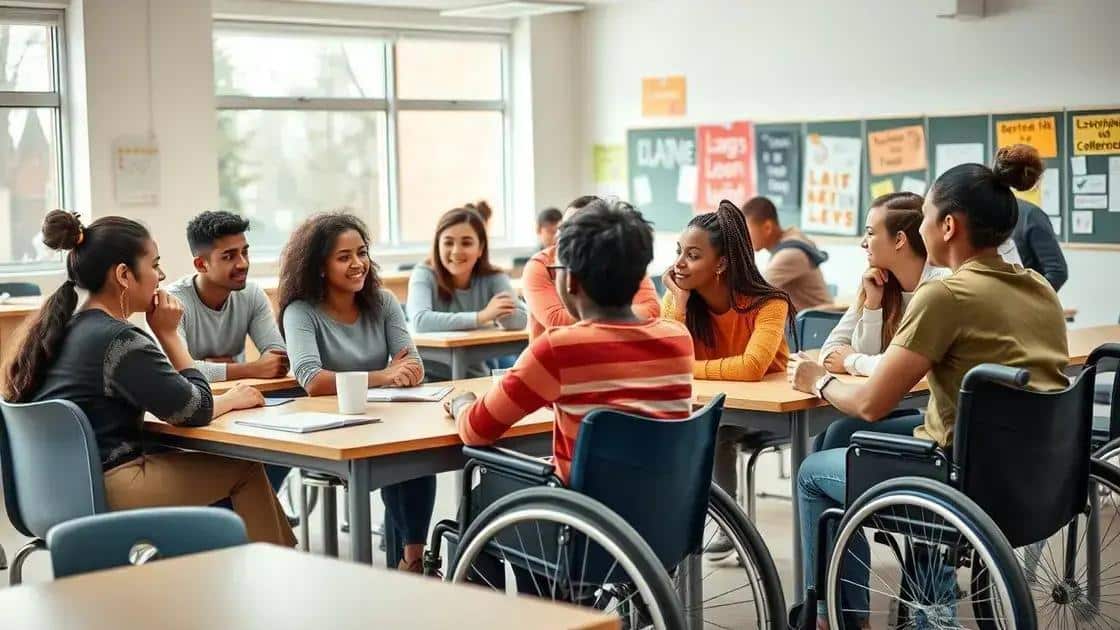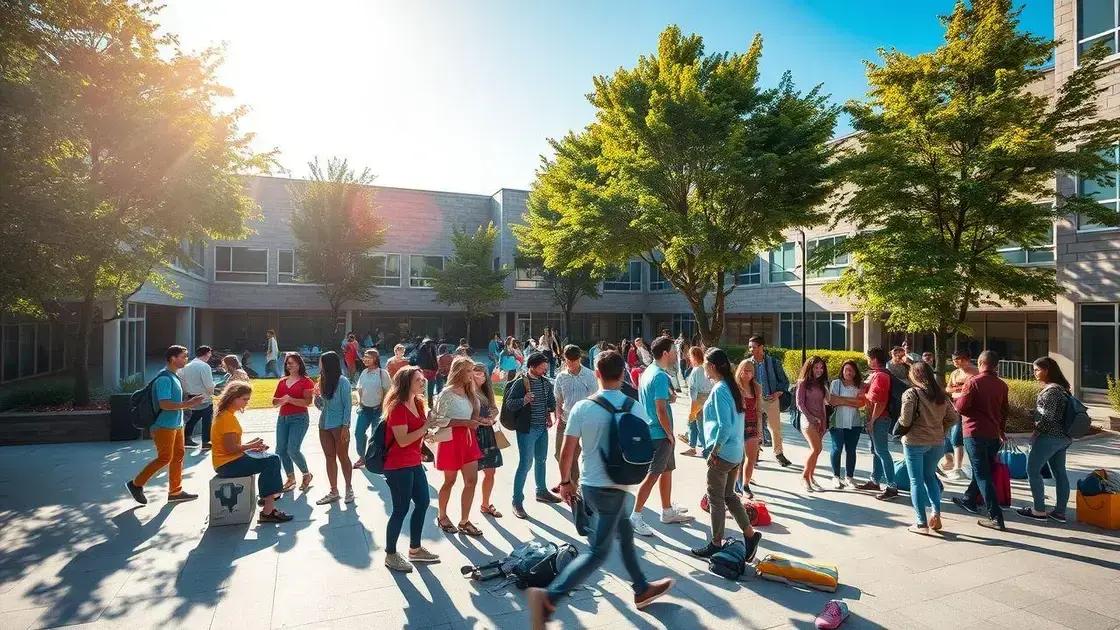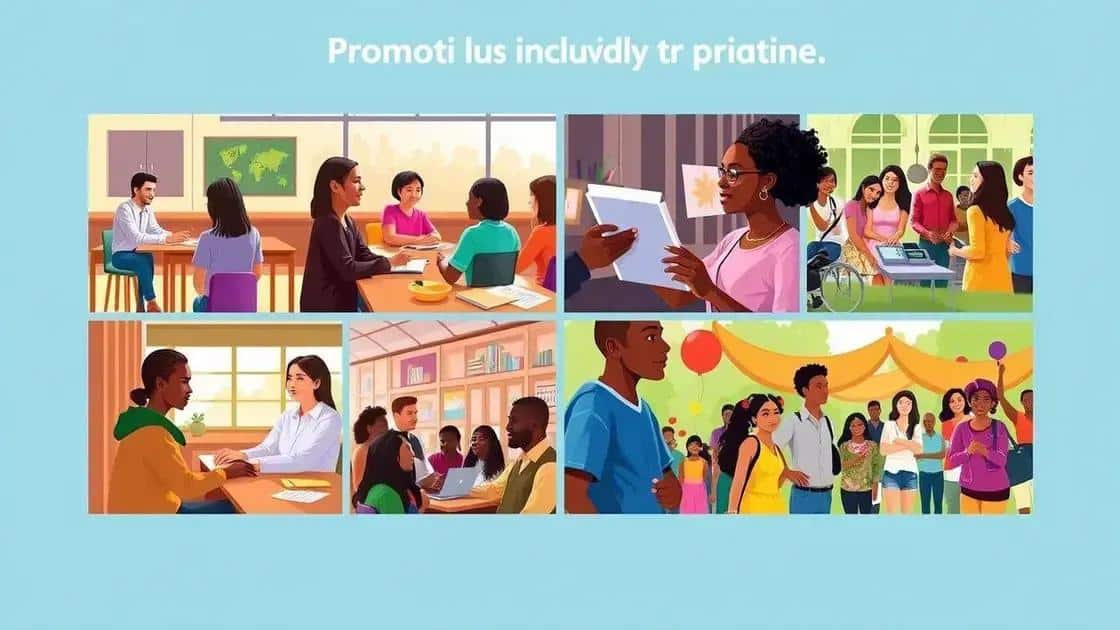Higher education accessibility: breaking down barriers

Anúncios
Higher education accessibility ensures all students, regardless of their background, can obtain quality educational opportunities through financial aid, inclusive programs, and technological advancements.
Higher education accessibility is more than just a trend; it’s a necessity for fostering equality in learning environments. Have you ever considered how education can shape futures? This article delves into the barriers faced by many and explores actionable solutions to ensure everyone has a chance to succeed.
Understanding higher education accessibility
Understanding higher education accessibility is crucial in today’s educational landscape. As society evolves, so do the opportunities for all students to pursue their dreams of higher education. However, many barriers still exist that can limit access to quality educational resources.
What is higher education accessibility?
Higher education accessibility refers to the ability of all students, regardless of their background, to obtain a college or university education. This concept includes various factors such as financial aid, physical access to campuses, and support for diverse learning needs.
Barriers to accessibility
Numerous challenges still hinder progress in higher education accessibility. Some common barriers include:
- High tuition costs that deter potential students
- Lack of support services for students with disabilities
- Geographical limitations preventing access to local colleges
- Socioeconomic backgrounds that influence educational opportunities
Understanding these barriers is essential for developing effective solutions. By addressing them, we can create more inclusive educational environments that support all students.
Moreover, higher education accessibility is not just an individual issue; it affects society as a whole. When more individuals can access education, the community benefits from a more educated workforce, leading to economic growth.
Strategies for improvement
Several strategies can enhance higher education accessibility:
- Expanding financial aid options to reduce tuition costs
- Implementing community outreach programs to raise awareness
- Creating more online courses to reach underserved areas
By continuously refining these efforts, we can make significant strides toward achieving equity in education.
Importance of inclusivity in campuses

Importance of inclusivity in campuses cannot be overstated. Ensuring that all students feel welcome and valued is key to fostering a positive learning environment. Inclusivity allows diverse perspectives to be shared, enriching educational experiences for everyone.
Why inclusivity matters
When campuses prioritize inclusivity, they create a supportive atmosphere for all students. This approach not only aids in personal growth but also enhances academic success. Students who feel included are more likely to participate actively in their education.
Benefits of an inclusive campus
There are numerous benefits associated with inclusivity in higher education environments. These include:
- Improved student retention and graduation rates
- Increased student engagement in campus activities
- Enhanced cultural awareness and sensitivity
- Creation of a more harmonious and respectful community
By embracing diversity, colleges and universities can better prepare students for the global workforce. Employers value teams that bring various viewpoints and experiences to the table.
How to promote inclusivity
Campuses can take several steps to promote inclusivity:
- Implement training programs on diversity and inclusion
- Establish support networks for marginalized groups
- Encourage diverse hiring practices among faculty and staff
These actions not only benefit students currently enrolled but also create a legacy of inclusion that future students will appreciate.
Strategies to enhance access for students
Strategies to enhance access for students are essential for creating a more equitable educational landscape. With proper measures, educational institutions can make learning opportunities available to everyone, regardless of their background.
Financial support options
One effective strategy involves expanding financial aid programs. Providing scholarships, grants, and low-interest loans can significantly reduce the burden of tuition costs. When students are less stressed about finances, they can focus more on their studies.
Improving campus infrastructure
Another important aspect is ensuring that campus facilities are accessible to all. This includes:
- Building ramps and elevators for students with physical disabilities
- Creating quiet study areas for students with learning differences
- Using technology to aid learning, such as text-to-speech software
When campuses are designed with inclusivity in mind, they create a supportive environment that benefits everyone.
Community outreach programs
Developing outreach programs can help raise awareness about higher education opportunities. Schools can partner with local organizations to:
- Host workshops on college readiness
- Provide information on financial aid options
- Encourage underrepresented groups to apply for college
These initiatives not only inform potential students but also demonstrate that institutions are invested in their success. Through such strategies, universities can build a diverse student body that reflects the community.
Real-life examples of effective solutions

Real-life examples of effective solutions showcase how various initiatives have successfully improved higher education accessibility. These examples demonstrate that change is possible when communities come together to address barriers.
Case Study: Community College Partnerships
Many community colleges have partnered with local high schools to increase student enrollment. For instance, programs that offer dual enrollment allow high school students to earn college credits while completing their secondary education. This not only reduces the cost of college but also equips students with the necessary skills and confidence.
Innovative Financial Aid Solutions
Some universities have implemented innovative financial aid solutions to ease the burden on students. One notable example is the University of California system, which developed a program to provide financial assistance to middle-income families. This initiative has significantly increased application rates from underrepresented groups.
Technology-Based Access Initiatives
Another effective solution involves leveraging technology to improve access to education. Online learning platforms make it possible for students in remote areas to participate in courses without geographical limitations. For example, schools like Georgia Tech offer fully online master’s degrees that bring world-class education to students who might not be able to attend in person.
Furthermore, some universities have invested in adaptive technologies that assist students with disabilities. Tools such as speech recognition software and accessible course materials ensure that every student can benefit from the learning environment.
Inclusive Campus Programs
Inclusive campus programs promote community and support among diverse student populations. Universities that host workshops, mentorship programs, and cultural events foster an environment where all students feel represented and heard. These initiatives often lead to higher retention rates and stronger academic performance.
Improving higher education accessibility is a vital step towards ensuring all students have the opportunity to succeed. By implementing effective strategies, such as financial aid programs, inclusive campus initiatives, and technology-based solutions, we can make a difference in many lives. Real-life examples show that with the right support, students from all backgrounds can thrive in their educational journeys. Ultimately, when we foster inclusivity and equal access in our educational institutions, we create a brighter future for everyone.
FAQ – Frequently Asked Questions about Higher Education Accessibility
What is higher education accessibility?
Higher education accessibility refers to the ability of all students, regardless of their background, to obtain quality education at colleges or universities.
Why is inclusivity important on college campuses?
Inclusivity is important because it creates a supportive environment where all students feel valued, encouraging participation and improving academic success.
What are some strategies to enhance access for students?
Some strategies include expanding financial aid options, improving campus infrastructure, and developing outreach programs to inform students about educational opportunities.
How has technology improved higher education access?
Technology has made it easier for students in remote areas to access online courses, and adaptive tools help students with disabilities to participate fully in their education.






